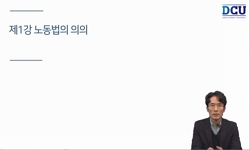At the center of the reciprocal relationship between the labor policy and the labor movement in the 1920s New York st ate lies the labor injunction. Stressing the essential role of the judiciary in constructing labor-capital relations, this article in...
http://chineseinput.net/에서 pinyin(병음)방식으로 중국어를 변환할 수 있습니다.
변환된 중국어를 복사하여 사용하시면 됩니다.
- 中文 을 입력하시려면 zhongwen을 입력하시고 space를누르시면됩니다.
- 北京 을 입력하시려면 beijing을 입력하시고 space를 누르시면 됩니다.

노동금지명령, 그 관행과 의미 : 1920년대 뉴욕주 노동법과 노사관계 Labor Law and Labor Relations in the 1920s New York State = The Labor Injunction, Its Meaning and Practice
한글로보기https://www.riss.kr/link?id=A19642723
-
저자
김진희 (Seoul Women's University)
- 발행기관
- 학술지명
- 권호사항
-
발행연도
2002
-
작성언어
Korean
-
주제어
labor law ; labor relations ; labor injunction ; New York State ; 1920s ; 노동법 ; 노사관계 ; 노동금지법 ; 뉴욕주 ; 1920년대 ; labor law ; labor relations ; labor injunction ; New York State ; 1920s ; 노동법 ; 노사관계 ; 노동금지법 ; 뉴욕주 ; 1920년대
-
KDC
920
-
등재정보
KCI등재
-
자료형태
학술저널
-
수록면
85-115(31쪽)
-
KCI 피인용횟수
1
- 제공처
-
0
상세조회 -
0
다운로드
부가정보
다국어 초록 (Multilingual Abstract)
The injunction prohibited workers from participating in a strike or a boycott if it could destroy an employer s property, which more often than not was interpreted broadly and arbitrarily. Throughout the 1920s, the labor injunction represented the most formidable weapon against organized labor and it achieved its widest use. Especially in New York State, courts issued more labor injunctions than in any other jurisdiction in any period. Employers hostile to organized labor found it an effective way to quash union-organizing campaigns. The labor injunction henceforth significantly imperiled union security.
Until the national emergency of the Great Depression and the legal revolution waged by Franklin D. Roosevelt and the New Dealers, the judiciary had both the power and the will to repress the rights of labor to organize, join the union and strike. But industrial unionists like Sidney Hillman were keen to keep alive the possibility of invoking law and public power on labors behalf while reformminded lawyers like Felix Frankfurter challenged the legal conservatives and attempted to transform the jurisprudence from the Victorian one to the pluralist one. While their effort s failed in the 1920s, both Hillman and Frankfurter finally became core members of the New Dealers during the next decade, and made contribution to the New Deal labor policy to be more egalitarian and livable for laborers. In the 1920s, as has been exemplified in the Michaels vs. Hillman, the seeds for the industrial democracy was burgeoning on the plot of sterile ground, waiting for the auspicious time to blossom, while the sustenance of the fruits still remained to be testified for decades to come.
At the center of the reciprocal relationship between the labor policy and the labor movement in the 1920s New York st ate lies the labor injunction. Stressing the essential role of the judiciary in constructing labor-capital relations, this article intends to show that the "lean years" of the 1920s was mainly due to the oppressive labor policy exemplified in the labor injunction.
The injunction prohibited workers from participating in a strike or a boycott if it could destroy an employer s property, which more often than not was interpreted broadly and arbitrarily. Throughout the 1920s, the labor injunction represented the most formidable weapon against organized labor and it achieved its widest use. Especially in New York State, courts issued more labor injunctions than in any other jurisdiction in any period. Employers hostile to organized labor found it an effective way to quash union-organizing campaigns. The labor injunction henceforth significantly imperiled union security.
Until the national emergency of the Great Depression and the legal revolution waged by Franklin D. Roosevelt and the New Dealers, the judiciary had both the power and the will to repress the rights of labor to organize, join the union and strike. But industrial unionists like Sidney Hillman were keen to keep alive the possibility of invoking law and public power on labors behalf while reformminded lawyers like Felix Frankfurter challenged the legal conservatives and attempted to transform the jurisprudence from the Victorian one to the pluralist one. While their effort s failed in the 1920s, both Hillman and Frankfurter finally became core members of the New Dealers during the next decade, and made contribution to the New Deal labor policy to be more egalitarian and livable for laborers. In the 1920s, as has been exemplified in the Michaels vs. Hillman, the seeds for the industrial democracy was burgeoning on the plot of sterile ground, waiting for the auspicious time to blossom, while the sustenance of the fruits still remained to be testified for decades to come.
목차 (Table of Contents)
- Ⅰ. 머리말 : 풍요의 시대, 노동의 흉작기
- Ⅱ. 노동금지 명령에 의한 지배
- Ⅲ. 맺음말 : 구원자의 발소리가 들려온다?
- Ⅰ. 머리말 : 풍요의 시대, 노동의 흉작기
- Ⅱ. 노동금지 명령에 의한 지배
- Ⅲ. 맺음말 : 구원자의 발소리가 들려온다?
동일학술지(권/호) 다른 논문
-
- 한국서양사학회
- 안상준
- 2002
- KCI등재
-
- 한국서양사학회
- 박현숙
- 2002
- KCI등재
-
- 한국서양사학회
- 김성준
- 2002
- KCI등재
-
- 한국서양사학회
- 김용우
- 2002
- KCI등재
분석정보
인용정보 인용지수 설명보기
학술지 이력
| 연월일 | 이력구분 | 이력상세 | 등재구분 |
|---|---|---|---|
| 2022 | 평가예정 | 계속평가 신청대상 (등재유지) | |
| 2017-01-01 | 평가 | 우수등재학술지 선정 (계속평가) | |
| 2013-01-01 | 평가 | 등재 1차 FAIL (등재유지) |  |
| 2010-01-01 | 평가 | 등재학술지 유지 (등재유지) |  |
| 2008-01-01 | 평가 | 등재학술지 유지 (등재유지) |  |
| 2006-01-01 | 평가 | 등재학술지 유지 (등재유지) |  |
| 2005-10-08 | 학술지등록 | 한글명 : 서양사론외국어명 : The Western History Review |  |
| 2004-01-01 | 평가 | 등재학술지 유지 (등재유지) |  |
| 2001-01-01 | 평가 | 등재학술지 선정 (등재후보2차) |  |
| 1998-07-01 | 평가 | 등재후보학술지 선정 (신규평가) |  |
학술지 인용정보
| 기준연도 | WOS-KCI 통합IF(2년) | KCIF(2년) | KCIF(3년) |
|---|---|---|---|
| 2016 | 0.31 | 0.31 | 0.23 |
| KCIF(4년) | KCIF(5년) | 중심성지수(3년) | 즉시성지수 |
| 0.26 | 0.26 | 0.494 | 0.13 |




 KISS
KISS






